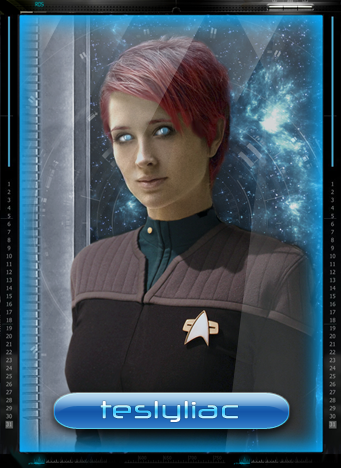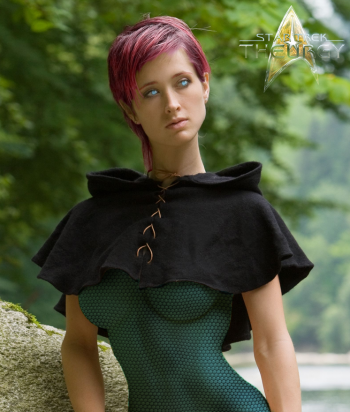Teslyliac
From Star Trek: Theurgy Wiki
In the great Valleys of the planet Teslylia III grew a rather strange plant, somewhat of a cross between the Lily of the Valley and a Watermelon. This unique species of plant had the ability to absorb genetic information, replicate it, and produce a nearly identical duplicate of the original source of the genetic material, though the process was not perfect. It is believed only a handful of specimens of this species remain alive, though it is difficult to tell as records from when the planet was made barren are extremely scarce. There are many ways to tell the original and the duplicates apart. Onthe cellular level, the Teslyliac Duplicate has more in common with a plant, having square shaped cells capable of photosynthesis. To the altered outward appearance, the duplicates always have bright blue eyes, no pupils, and brightly colored hair that has more in common with a petal then with true hair.
For the purposes of this Racial Profile we shall only explore the nature of human Teslyliac Duplicates.
Physiology
After the genetic material is collected by one of the Teslyliac Plants a pod is created. Every section of the plant can receive this genetic material, though it’s buds are the most likely to produce a pod when exposed. Less complex life forms take less time to duplicate and more complex life forms take longer. The average amount of time to duplicate a humanoid is roughly 2 weeks. After the pod opens the duplicate is about the same development as an infant, roughly 9 months after conception for humans. This rapid development does not cease until 6 months have passed at which time the duplicate has reached physical and mental maturity.
During this developmental time the Teslyliac will absorb as much information as it possibly can to better adapt towards life. There is no known life expectancy of a Teslyliac Duplicate, members of the race do not exhibit traditional signs of aging past the point of physical maturity. It is hypothetically possible that giving the right circumstances a Teslyliac Duplicate could live indefinitely, though this is unlikely. Given the possibility of injury and in turn death the Teslyliac have a unique physiological quirk in which a new Teslyliac plant will grow from the remains of any Teslyliac Duplicate and giving the right circumstances a new duplicate will be created with the same genetic structure as the duplicate the plants grew from. In some cases it is believed that the memories and life experiences would be passed onto the new duplicate, thus creating a form of immortality. Though the conditions for this must be ideal or the plant will return to it's natural blank template.
As an additional note, Teslyliac memories have proven to be highly efficient at storing and recalling a wide range of information.
One of the most obvious things to note about a Teslyliac Duplicate is the light blue eyes which lack pupils. The structure of their eye is vastly different from that of most other life forms as the retina, the cells that receive the image and project it to the brain, is not behind a lens and a layer of fluid, but rather sits directly in front of the eye, this is the pale blue circle most would think is the iris. The rest of the eye is a complex processing system designed to filter out various information. In some cases Teslyliac eyes have developed the ability to see beyond the normal color range that is the visible spectrum and into higher or lower spectrums, however this is rare.
The hair of a Teslyliac is most likely the next to be noticed, if you didn’t notice it first that is. This “hair” is not truly anything close to hair at all; it is actually a form of petal, growing long and extremely thin. It ranges in color from bright blue to a deep vivid red. Curiously this petal hair changes color to show the condition of the Teslyliac, growing brighter and more vivid when they are doing well and duller and darker when they are not. Additionally the hair has recently been discovered to possess certain bioluminescent properties when the Teslyliac “blooms,” more on this phenomenon in the next paragraph. It is said to give off a pleasant floral smell, though the purpose of the smell is unknown.
Lastly, the Teslyliac Duplicate is capable of blooming. This phenomenon has been rarely observed and has been shown to be related to sexuality. In times of sexual arousal, the Teslyliac’s hair and chlorophyll-rich fluid within her circulatory system begin to create bioluminescent light. The light of which will continue to grow until their peaks near 900 lumens, though rare instances of as high as 1,500 lumens have been observed. This light ranges most of the visual spectrum and does produce a limited amount of ultraviolet light. Further radiological tests have not been done and ship sensors have not detected levels above what is considered the background of high energy radiation. During this time the duplicates sexual organs began to produce a nectar-like substance, similar to honey though it is far more liquid. If sexual stimuli is received this nectarous fluid increases. At the moment of peak sexual pleasure, or rather orgasm, an enzyme is released that converts said fluid into a potent narcotic. Not many official tests have yet been performed on this narcotic, though it has been shown to be nonaddictive and nontoxic. Due to structural difference in both the genetic and cellular levels, there are no known species which a Teslyliac Duplicate can biologically reproduce with.
Teslyliac diet consists mainly of mineral water and simple sugars. They lack the digestive enzymes to digest any sort of meat or vegetable, consuming these results in extreme gastro-intestinal distress and in some rare cases death. Though the Teslyliac Duplicate's body contains all of the standard orifices one would expect to find on any humanoid they do not urinate or defecate. In the few cases where a Teslyliac Duplicate has eaten or drank anything beyond simply nutrients or water, the body rejected it almost immediately. In addition Teslyliac require exposure to solar radiation of some sort for at least 8 hours a day, when a star is not available certain unique nebulous formations will also produce the necessary radiation. In most cases a simple solar lamp will work, though no portion of the skin may be covered during exposure for the full benefits to be received.
Teslyliac Typing
Since the discovery of the Teslyliac Duplicate function, there has not been a great deal of research into them outside of a few select entities which have done said research. One of these entities has discovered 3 unique Typings of Tgeslyliac Duplicate each with unique characteristics and properties. Given the nature of each of these being artificially created, it is not known if these are natural phenomena or a result of the process through which the duplicates were created.
Type A
Referred to as a Type A Teslyliac Duplicate, this is by far the most advanced version. It is created by an abnormal amount of energy being absorbed by the duplicate and thus charging the photosynthesis cells to the point they are able to activate secondary functions of metabolic reactions. Once activated these functions continue. The direct effect is increased memory retention, though duplicates show eidetic memory Type A duplicates are able to recall with even greater clarity. It has been discovered that memories can be implanted and kept stored until such a time as the duplicate achieves Type A status at which time they will be unlocked.
The Type A duplicate is able to trigger their bloom function at will, allowing to not only produce photosynthetic light, but also the aforementioned narcotic. They are able to release a special enzyme that converts the narcotic into a powerful neurotoxin which paralyzes the victim, even so far as preventing them from breathing. This can be alleviated by the narcotic element which has been found to contain elements to aid in breathing and opening the airway. The exact effects of this neurotoxin have not been fully studied and are believed to be different in between species due to unique biochemical reactions different in unique individuals and unique species.
In addition the Type A duplicate produces an increased amount of oxygen in their breathing cycle. While as normal duplicates produce an average amount of 550 cubic liters of pure oxygen a day, a Type A duplicate will produce 1,500 cubic liters of oxygen a day.
Type B
The Type B duplicate is thus far the only form of duplicate known in the Federation. The only 3 individuals of confirmed Teslyliac Duplicate status are all Type B. All information above should be regarded as a standard of Type B.
Type C
Currently, all information on Type C Duplicates is classified. It is assumed they are a more refined version of Type B, though not as refined as Type A.
Psychology
Teslyliac psychology is as varied as any other race. They are capable of a range of emotions; though due to not having a normal sort of childhood they lack a number of valuable experiences and social skills. This can be learned, though as always this does take time.
The only consistent psychological trait the vast majority of the race share is an extreme aversion toward lying. Though they are capable of it, they usually will do anything they can to avoid needing to.
Language
The Teslyliac has no native language, they learn the language spoken around them most during their developmental stage and continue to use that language. They are capable of learning more and even adapting their vocal cords to accommodate more unusual languages.
Home World
The Teslyliac Plant originates on Teslylia III, a now barren planet. During the Dominion Conflict a Dominion Outpost was built there after it was discovered that certain enzymes in the Teslyliac Plant could be used to produce Ketrasil White. In the end the great valleys of Teslyliac plants were burned to the ground by Klingon Infiltrators to stop the development of the White. Only a few plants survived the purge and were taken to research facilities around the Alpha and Gamma Quadrant. The nearest one to Teslylia III was set up on Teslylia IV, though this facility was destroyed under mysterious circumstances only a few years later.
Culture & Customs
The Teslyliac have no culture of their own, instead they adapt to any culture they go through their developmental stage in.
History
For the longest time, the Teslyliac Plant was a myth, told by deep space traders around bar tables and campfires to anyone who would listen. The first confirmed sighting of a Teslyliac Duplicate was in the late 23th century, though the actual source of the plant was unknown at that time. It was not until the mid 24th century that the planet of Teslylia III was shown to house this unique plant, though this was kept a secret, as the Federation feared the implications of using the plant.
In the late 24th century, during the Dominion War, a Dominion Outpost was set up on the planet. The Events of the war would destroy the majority of the Teslyliac Plants, those that remained were scattered around research facilities in the Alpha and Gamma Quadrants.
Government & Military
The Teslyliac do not have a Governmental body, instead, they tend to express allegiance to whichever government housed them during their developmental stage. Interestingly most Teslyliac tend to prefer peaceful solutions and abhor violence, though a few have exhibited violent tendencies.
Technology
The Teslyliac have no technology of their own, though they have been shown to adapt to new technology easily.
Mythology
The Teslyliac have no mythology as such, though there is a rumor that they do have a racial memory that predates all known life, though most know examples of a Teslyliac duplicate do not have access to such memories, if they exist at all.
Special Notes
The Teslyliac are not a people as such, instead they are a race made up of individuals. The only groups that tend to bond together are ones created from the same genetic template.
This race is heavily inspired by the Yoeshin race created by An-Gel Sakura of the Star Trek Photomanipulation Archive forum. Though there have been a number of changes from the original Yoeshin race to the Teslyliac race, there are still a number of clear similarities that the connection should be noted.




